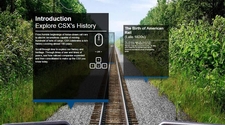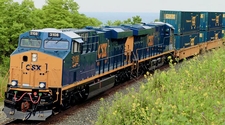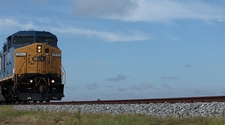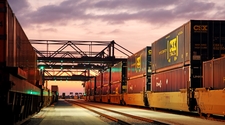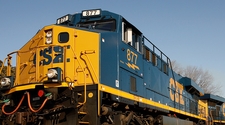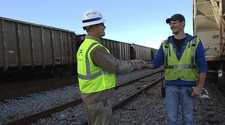| ICE |
Integrated Cab Electronics (EMD). A system that uses computer screens to replace the conventional gauges and dials on a locomotive control stand. |
| Idler Car |
Usually a flat car used in the transportation of a long article or shipment which extends beyond the limits of the car carrying the shipment. The "idler" is a car on which the shipment or article does not rest, but overhangs. |
| IFC |
Integrated Function Control (GE). A system that uses computer screens to replace the conventional gauges and dials on a locomotive control stand. |
| IIDS |
Industrial Inventory Demurrage Switching System. A computer system which interfaces with all major transportation data systems and eliminates manual calculation of demurrage and other accessorial charges. |
| Impact Recorder (AKA Impact Register) |
A mechanical device used in or on a car to register shock or vibration to the car. |
| Import |
To receive goods from any foreign country. |
| Import Rate |
A rate established specifically for application on import freight, and generally lower than and taking precedence over domestic rates. |
| Improper Signal Aspect |
A signal aspect that permits a train to proceed when the condition of the block does not justify such an aspect. |
| In Advance of a Signal |
A term used in defining the territory beyond a signal as seen from an approaching train. |
| In Approach of a Signal |
A term used in defining the territory to which a signal indication is conveyed. |
| In Care Of |
A shipment to be delivered to a location other than that of the consignee's location. The waybill must be noted with both the actual customer and the receiving customer. |
| In The Clear |
A car (or train) is in the clear when it has passed over a switch and frog so far that another car (or train) can pass without collision. A car or train not blocking or fouling tracks. See On the Foul. |
| In The Hole (Slang) |
In a siding. |
| In-Bond Shipment |
An import or export shipment which has not been cleared by Federal customs officials. |
| In-Gate |
Term used to indicate that a trailer or container has been brought into an intermodal site by a drayman. |
| Inbound Train |
A train arriving at a yard or terminal. |
| Incidental Bill |
A bill for charges accruing to a customer due to switching, demurrage, detention, storage, etc. |
| Increase Level |
A specific amount added to the freight charges of a shipment to cover increased carrier costs. OR A field within the rate master that carries the identification of a publication that represents a RCCR (Rail Carrier Cost Recovery) increase. |
| Indemnity Agreement |
A form protecting CSXT from duplicate claims on the same adjustment or correction. |
| Independent Brake Valve |
A manually operated pneumatic valve in the locomotive cab used to apply and release locomotive brakes independently of train brakes. |
| Independent Contact |
A contacting member designed to complete one circuit only. |
| Indication |
The information conveyed by a signal. |
| Individual Lines Tariff |
A tariff published by a particular railroad for its own use. |
| Industrial Carrier, Industrial Line, or Industrial Road |
A short railroad owned or controlled by one or more of the principal industries served by it. |
| Industrial Interchange |
Interchange of cars from one railroad to another which takes place within the confines of a customer's plant. |
| Industrial Track |
A switching track serving industries, such as warehouses, mines, mills, factories, etc. |
| Inflammable Liquids |
Liquids that give off vapors which become combustible at a certain temperature. |
| Ingot |
A mass of metal shaped for the convenience of storage or transportation. |
| Initial and Number |
The two parts of car identification. Together, they constitute the car number. |
| Initial Carrier |
The carrier serving the location where the shipment originates. |
| Initial Reduction |
The first of one or more brake pipe reductions made with the automatic brake valve. |
| Initiation Fee |
A standard fee required by the union as a condition of obtaining membership in the union. |
| Inland Carrier |
A transportation line which hauls export or import traffic between ports and inland points. |
| Input |
Data prepared and transmitted to the computer. |
| Input Field |
Location on a computer screen where data may be typed. |
| Inspection |
To check over product for the purpose of determining its quality and condition and to determine responsibility for loss or damage. |
| Insulated Rail Joint |
A joint in which electrical insulation is provided between adjoining rails. |
| Insulated Rod |
A metal rod in which insulation has been inserted between its abutting ends to prevent passage of current through the rod. |
| Inter-Terminal Switching |
The switching of cars from one location to another within a terminal area, but involving two or more railroads. |
| Interchange |
The transfer of cars from one railroad to another at a common junction point. |
| Interchange Point |
The location or junction where cars are transferred from one railroad to another. |
| Interchange Switching |
The service performed in transferring cars from one transportation carrier to another as part of a through movement. |
| Interchange Track |
A track on which freight is delivered by one transportation carrier to another. |
| Intercooler |
That part of the air compressor used for cooling the compressed air between stages of compression. |
| Interfaced Waybill |
A waybill created in AWS that has all necessary information to legally move a freight car. When all of the billing information is complete, the computer will generate a freight bill to the customer. |
| Interline |
Traffic that moves between two or more carriers. |
| Interline Forwarded |
A shipment which originates on CSXT but terminates on a non-CSXT carrier. |
| Interline Freight |
See Interline Shipment. |
| Interline Received |
A shipment which originates on a non-CSXT carrier but terminates on CSXT. |
| Interline Shipment |
Freight moving from point of origin to destination over the lines of two or more railroads. |
| Interline Waybill |
A waybill covering the movement of freight over two or more transportation carriers' tracks. |
| Interlocking |
An arrangement of interconnected signals and signal appliances for which interlocking rules are in effect. Signals and movement of signal appliances must succeed each other in proper sequence. |
| Interlocking Limits |
The tracks between the extreme opposing home signals of an interlocking. |
| Interlocking Signals |
The fixed signals of an interlocking. |
| Intermediate Carrier (AKA Bridges or Overhead Carrier) |
A railroad over which a shipment moves but on which neither the point of origin nor destination is located. |
| Intermediate Clause |
A clause contained in a tariff which provides for rates to or from an intermediate point. |
| Intermediate Pick-Up |
Location or activity between the origin and destination of a train where cars are added to the train. |
| Intermediate Point |
An unnamed location between two specifically named points. |
| Intermediate Signal |
A block signal equipped with either a number plate, a "G" marker or a "P" marker. It conveys "Stop and Proceed at Restricted Speed" as its most restrictive indication. |
| Intermediate Switching |
Switching service performed which includes all the elements of switching performed by a carrier that neither originates nor terminates the shipment nor receives a line haul on that shipment. |
| Intermodal |
A flexible way of transporting freight over water, highway and rail without being removed from the original transportation equipment, namely a container or trailer. |
| Intermodal or Piggyback Facility |
A loading and/or unloading ramp for TOFC/COFC traffic only. The ramp may or may not be adjacent to a freight yard. |
| Intermodal Rules Tariff |
Tariff with published rules and regulations governing class, commodity and freight rates applying on shipments loaded in or on trailers, containers, or demountable trailer bodies and transported on flat cars. |
| Intermodal Train |
A freight train that consists of any combination of roadrailer equipment, double-stack or pedestal flat cars, and flat cars equipped for TOFC, COFC, multi-level auto-rack or auto frames. |
| Interstate Commerce Act |
An act of Congress, regulating the practices, rates, and rules of transportation lines engaged in handling interstate traffic. |
| Interstate Traffic |
Traffic moving from a point in one state to a point in another state or between points in the same state, but must pass within or through another state en route. |
| Intra |
Within. |
| Intra-Plant Switching |
The movement of cars from one place to another within the confines of a single industry. |
| Intra-Terminal Switching |
Switching service performed in handling a car from a track served by the same carrier when both tracks are within the switching limits of the same station or industrial switching district. |
| Intrastate Traffic |
Traffic between two locations in a single state and the movement is wholly within the state boundaries. |
| Inventory control |
See TYMS. |
| IRDE |
Interline Received Data Exchange System. |
| Iron (Slang) |
See Switch. |
| Issuing Carrier |
The carrier publishing a tariff or issuing a bill of lading or other document. |
| Item |
A tariff provision of any kind bearing an "Item Number" designation. |
| back to top |


